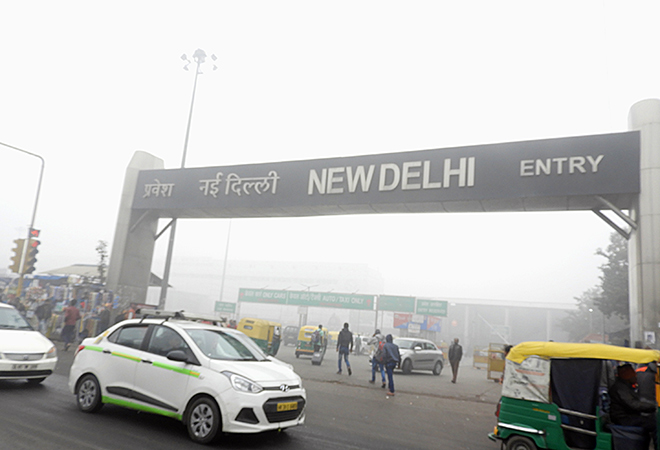
Waste management and air pollution are becoming the leading concerns of public health in the national capital of Delhi. The toxic subsystem created by ill managed waste and its disposal adds to the worsening air quality of Delhi. In addition, a study by Ganga Ram Hospital has revealed that 50% of the population of Delhi is at risk of contracting lung cancer even if they do not smoke. Maybe it's time to ring the alarm bells.
The Lancet Commission on pollution and health ranked India number one with 2.51 million deaths in 2015 due to pollution. Furthermore, the ambient air quality report of 2017 (Delhi), as released by the Central Pollution Control Board of India, shows that there were only 45 days with satisfactory air quality in Delhi through 2017. As of May 2018, there has only been one day with satisfactory air condition in the Delhi-NCR region . ‘Satisfactory air days’ as per the Air Quality Index legend is acceptable; yet people suffering from respiratory ailments have a tough time.
Air Quality in Delhi has been deteriorating at an alarming pace. The main causes for this include diesel, petrol and coal combustion (50%), biomass burning (20%), industries (20%) and the rest being dust deposits. Out of these cases, the role of waste management systems contributing to air pollution in Delhi is often overlooked. Similar to emissions from power plants, the waste management systems located in the city add some of the most harmful particulate matter to the already unbreathable Delhi air.
Waste management is carried out in two ways by the five Municipal Corporations responsible for waste disposal. On a daily basis, Delhi generates 9,500 tonnes of waste which is disposed of either through dumping at the three commissioned landfill sites or by incineration at three ‘Waste to Energy’ plants built in and around the national capital.
Organic decomposition of food waste mixed with municipal solid waste at landfill sites leads to high amounts of emissions. Approximately 50% of gas emitted from landfills is methane; carbon dioxide accounts for about 45%, and the remainder is composed of nitrogen, oxygen, hydrogen, and other gases. The two main components of the emissions i.e. carbon dioxide and methane are also well recognised GHGs (Greenhouse gases) adding to the air quality woes of Delhi.
The alternative, incineration of this very waste is more harmful to the environment and living organisms subject to the emissions of ‘waste to energy’ plants. Four kinds of waste find its way to the three waste to energy plants located in Delhi. These are plastic waste, electronic waste, biomedical waste and construction and demolition waste. Incineration of this waste is highly inefficient as well as harmful, due to the composition of the emissions. It is essential to note here that the incinerator also emits more CO2 per MW/hour than any fossil fuel based power source, including coal/fuel power plants. Shredded chlorinated plastic, municipal solid waste which cannot be segregated at source or point of use, when burnt, releases highly toxic compounds such as Dioxins, Furans, heavy metals and other pollutants which are carcinogenic in nature. Incinerators also develop toxic ash or slag that must be then deposited into landfills. This ash contains heavy metals and gas pollutants which are toxic and pollute underground water.
In 2013, residents of Sukhdev Vihar, New Delhi filed a case at the National Green Tribunal (NGT) requesting the closure of the Timarpur Okhla waste to energy plant which was found to be violating the pollution limits till December 2014. Yet the court ruled against the closure and asked for stricter quality checks by the Central Pollution Control Board and the Delhi Pollution Control Committee and imposed a fine as environmental compensation of 25 lakh rupees for violation of compliance limits until December 2014. With all the discoveries of the reports and substantiation of the same at the NGT, the plant was given a green light to continue functioning at optimum capacity until further notice by the CPCB/DPCC and NGT. As of today, the last Ambient Air Quality report of the plant was produced by Shriram Institute of Industrial Research was in December 2015 i.e. nearly 3 years ago and the results were as shown in the below table.

It can be clearly seen that even as of December 2015, only a couple of months after the judgement of the National Green Tribunal, the plant was violating compliance limitations in five of the 12 categories, namely Respirable Particulate Matter (PM10), Fine Particulate Matter (PM2.5), Ozone (O3), Benzene (C6H6) and Nickel (Ni) all of which are highly toxic and harmful to the environment and public health. Another point to be noted here is that these results are based out of testing the emissions for only a 24 hr period. Compounding the same to a month-long period or a year invokes serious trepidation.
The aforementioned case shows signs of environmental injustice, as benefits of the few have been valued over the lives of thousands of people subject to inhaling the emissions of such waste to energy plants. When brought to the doors of the judicial system, the rulings are circumstantially upheld to save the face of corporates running these plants with no compensation for the thousands who may suffer ailments due to the pollution caused by such plants.
Yet, the question that comes up is, ‘why after getting such results in December 2015, have no further tests been conducted?’ Most recent news from 2017 around this case showcases the inability/lack of capacity of the CPCB to conduct regular checks of the ambient air quality, emboldening the voices of concern. The relationship between the judicial system, the pollution regulatory authorities and the corporates, who are building such projects, is something worth taking a second glance at.
In the thick of things, it is easy to forget about the other two waste to energy plants present in the city – at Ghazipur and Narela. These two plants generate 36 MW, but neither have been regularly tested for emissions violations. Unlike the plant in Sukhdev Vihar, which had the Resident Welfare Association go to the National Green Tribunal, these plants are situated in the impoverished and underdeveloped areas of the city. The inability of the people living around these plants to understand the health implications and protest against the functioning of these plants represents the kind of environmental classism prevalent in the capital.
Such waste to energy plants are not an occurrence of the 21st century but have been looked at as viable green options since the 19th century. Over the past three decades, a plethora of research has been done into understanding the harmful impacts of such plants and coming up with alternative ways to make their functioning safer. Short term solutions for treating the air pollution menace would include establishment of a viable system of segregation of waste, re-classification of waste and proper equipment for studying the ambient air quality around the main waste to energy plants. On a long term level, alternatives like low heating technology like autoclaves and microwaves, which help in disinfecting biomedical waste before incineration, reducing the amount of Dioxins and Furans released post incineration of the waste, are viable and should be utilised.
The rate of decay of the current air quality standards in Delhi is unprecedented; and the looming public health crisis is inevitable. The gradual transition and implementation of solutions with help from the regulatory and judicial system of the national capital is key to maintaining good health conditions for its two crore citizens.
The views expressed above belong to the author(s). ORF research and analyses now available on Telegram! Click here to access our curated content — blogs, longforms and interviews.





 PREV
PREV

